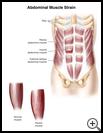
Abdominal Muscle Strain: Teen Version
________________________________________________________________________
KEY POINTS
- An abdominal muscle strain is a stretch or tear of a muscle in your belly. A strain may also be called a "pulled" muscle.
- Change or stop doing the activities that cause pain until the injury heals.
- Strains can be treated with moist heat, ice, medicine, and sometimes physical therapy.
________________________________________________________________________
What is an abdominal muscle strain?
An abdominal muscle strain is a stretch or tear of a muscle in your belly. A strain may also be called a "pulled" muscle.
What is the cause?
You may strain your muscles during an activity like lifting or twisting or even hard coughing or sneezing. Muscles can also get strained from overuse, like from doing lots of sit-ups or crunches.
What are the symptoms?
You have soreness or pain in the surface of your belly, especially when you use your abdominal muscles. You may have bruising if you have torn a muscle.
How is it diagnosed?
Your healthcare provider will ask about your symptoms, medical history, and activities and examine your belly. Your provider will ask you to do an exercise, like a sit-up, to see if it causes pain. You may have tests to look for other causes of the pain.
How is it treated?
You will need to change or stop doing the activities that cause pain until your muscles have healed.
Your healthcare provider may recommend stretching and strengthening exercises and other types of physical therapy to help you heal.
A mild strain may heal within a few weeks. A more severe strain may take 6 weeks or longer.
How can I take care of myself?
To help relieve pain:
- Put an ice pack, gel pack, or package of frozen vegetables wrapped in a cloth on the sore area every 3 to 4 hours for up to 20 minutes at a time.
- Take nonprescription pain medicine, such as acetaminophen, ibuprofen, or naproxen. Read the label and take as directed. Unless recommended by your healthcare provider, you should not take these medicines for more than 10 days.
- Nonsteroidal anti-inflammatory medicines (NSAIDs), such as ibuprofen, naproxen, and aspirin, may cause stomach bleeding and other problems. These risks increase with age.
- Acetaminophen may cause liver damage or other problems. Unless recommended by your provider, don't take more than 3000 milligrams (mg) in 24 hours. To make sure you don’t take too much, check other medicines you take to see if they also contain acetaminophen. Avoid drinking alcohol while taking this medicine.
- Put moist heat on the sore area for 10 to 15 minutes before you do warm-up and stretching exercises. Moist heat may help relax your muscles. Moist heat includes heat patches or moist heating pads that you can buy at most drugstores, a wet washcloth or towel that has been heated in a microwave or the dryer, or a hot shower. Don’t use heat if you have swelling.
Follow your healthcare provider's instructions, including any exercises recommended by your provider. Ask your provider:
- How and when you will get your test results
- How long it will take to recover
- If there are activities you should avoid and when you can return to normal activities
- How to take care of yourself at home
- What symptoms or problems you should watch for and what to do if you have them
Make sure you know when you should come back for a checkup. Keep all appointments for provider visits or tests.
How can I help prevent abdominal muscle strains?
Warm-up exercises and stretching before activities can help prevent injuries. Strong, flexible muscles are less likely to be strained. You can strengthen your abdominal muscles by doing sit-ups or abdominal crunches.
Be sure to not overdo it when you start an exercise program.
When you lift heavy objects, bend your knees and hips and keep your back straight.
Last modified: 2019-04-05
Last reviewed: 2017-06-26

